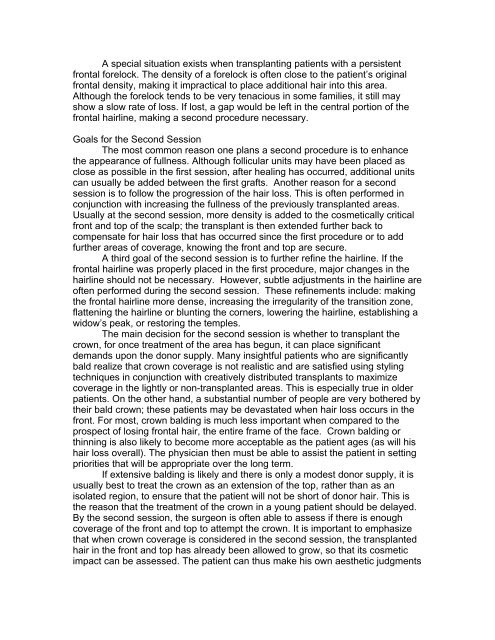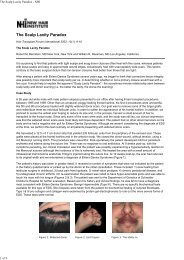The Patient's Guide to Hair Restoration - New Hair Institute
The Patient's Guide to Hair Restoration - New Hair Institute
The Patient's Guide to Hair Restoration - New Hair Institute
Create successful ePaper yourself
Turn your PDF publications into a flip-book with our unique Google optimized e-Paper software.
A special situation exists when transplanting patients with a persistent<br />
frontal forelock. <strong>The</strong> density of a forelock is often close <strong>to</strong> the patient’s original<br />
frontal density, making it impractical <strong>to</strong> place additional hair in<strong>to</strong> this area.<br />
Although the forelock tends <strong>to</strong> be very tenacious in some families, it still may<br />
show a slow rate of loss. If lost, a gap would be left in the central portion of the<br />
frontal hairline, making a second procedure necessary.<br />
Goals for the Second Session<br />
<strong>The</strong> most common reason one plans a second procedure is <strong>to</strong> enhance<br />
the appearance of fullness. Although follicular units may have been placed as<br />
close as possible in the first session, after healing has occurred, additional units<br />
can usually be added between the first grafts. Another reason for a second<br />
session is <strong>to</strong> follow the progression of the hair loss. This is often performed in<br />
conjunction with increasing the fullness of the previously transplanted areas.<br />
Usually at the second session, more density is added <strong>to</strong> the cosmetically critical<br />
front and <strong>to</strong>p of the scalp; the transplant is then extended further back <strong>to</strong><br />
compensate for hair loss that has occurred since the first procedure or <strong>to</strong> add<br />
further areas of coverage, knowing the front and <strong>to</strong>p are secure.<br />
A third goal of the second session is <strong>to</strong> further refine the hairline. If the<br />
frontal hairline was properly placed in the first procedure, major changes in the<br />
hairline should not be necessary. However, subtle adjustments in the hairline are<br />
often performed during the second session. <strong>The</strong>se refinements include: making<br />
the frontal hairline more dense, increasing the irregularity of the transition zone,<br />
flattening the hairline or blunting the corners, lowering the hairline, establishing a<br />
widow’s peak, or res<strong>to</strong>ring the temples.<br />
<strong>The</strong> main decision for the second session is whether <strong>to</strong> transplant the<br />
crown, for once treatment of the area has begun, it can place significant<br />
demands upon the donor supply. Many insightful patients who are significantly<br />
bald realize that crown coverage is not realistic and are satisfied using styling<br />
techniques in conjunction with creatively distributed transplants <strong>to</strong> maximize<br />
coverage in the lightly or non-transplanted areas. This is especially true in older<br />
patients. On the other hand, a substantial number of people are very bothered by<br />
their bald crown; these patients may be devastated when hair loss occurs in the<br />
front. For most, crown balding is much less important when compared <strong>to</strong> the<br />
prospect of losing frontal hair, the entire frame of the face. Crown balding or<br />
thinning is also likely <strong>to</strong> become more acceptable as the patient ages (as will his<br />
hair loss overall). <strong>The</strong> physician then must be able <strong>to</strong> assist the patient in setting<br />
priorities that will be appropriate over the long term.<br />
If extensive balding is likely and there is only a modest donor supply, it is<br />
usually best <strong>to</strong> treat the crown as an extension of the <strong>to</strong>p, rather than as an<br />
isolated region, <strong>to</strong> ensure that the patient will not be short of donor hair. This is<br />
the reason that the treatment of the crown in a young patient should be delayed.<br />
By the second session, the surgeon is often able <strong>to</strong> assess if there is enough<br />
coverage of the front and <strong>to</strong>p <strong>to</strong> attempt the crown. It is important <strong>to</strong> emphasize<br />
that when crown coverage is considered in the second session, the transplanted<br />
hair in the front and <strong>to</strong>p has already been allowed <strong>to</strong> grow, so that its cosmetic<br />
impact can be assessed. <strong>The</strong> patient can thus make his own aesthetic judgments



